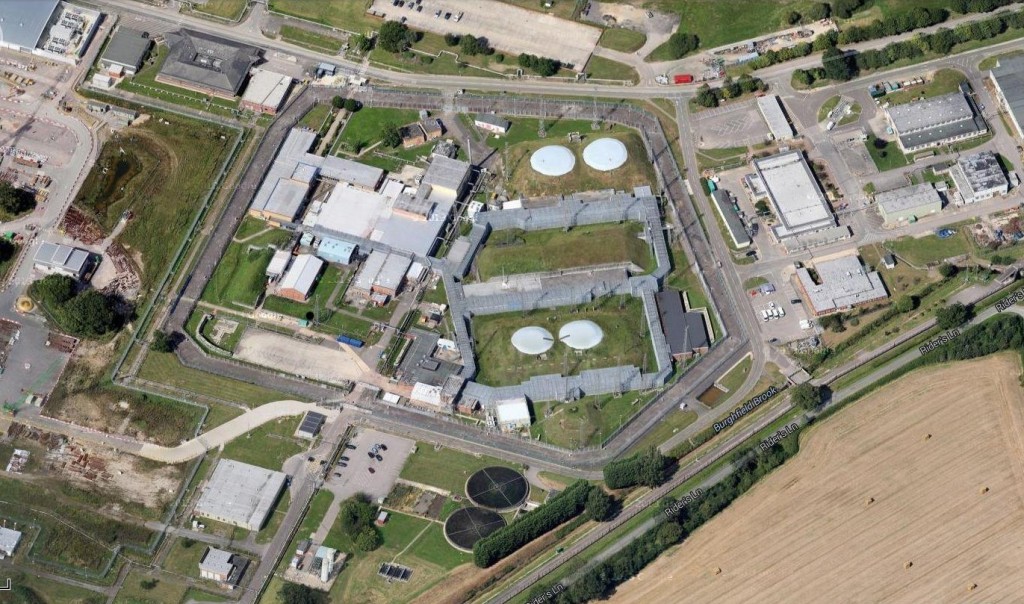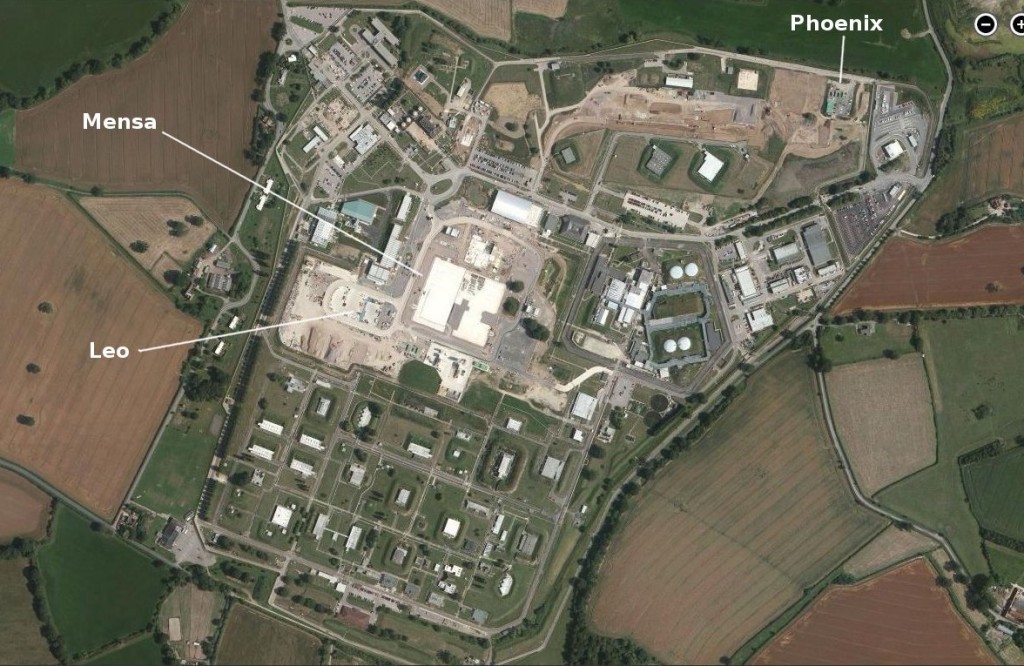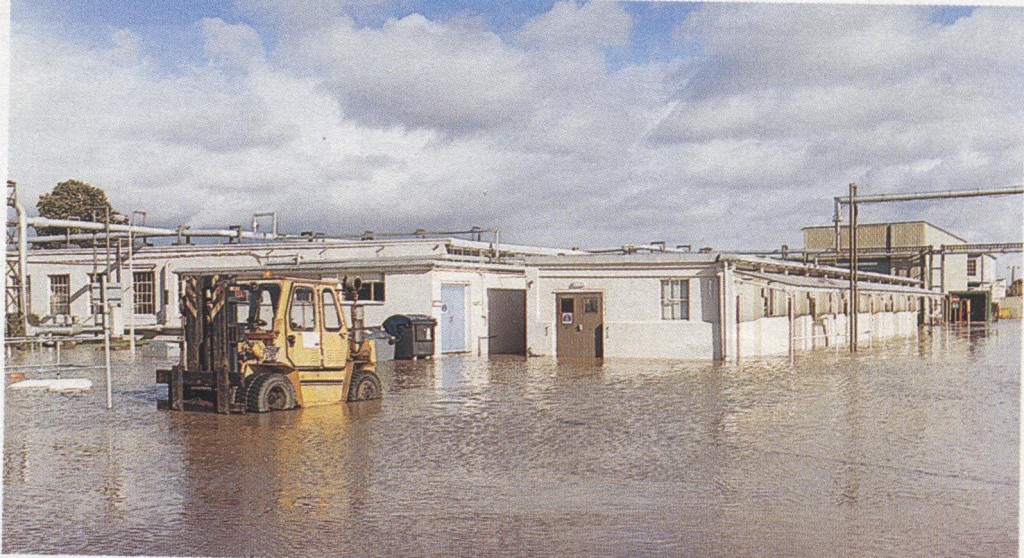AWE Burghfield
The Atomic Weapons Establishment (AWE) at Burghfield, a former World War 2 munitions factory, occupies a 225 acre site between Aldermaston and Reading. It is responsible for the final assembly of UK Trident nuclear warheads and their disassembly and maintenance while in service. Over 300 employees work at the site, as well as contractors working on construction projects. The site is owned by the Ministry of Defence (MoD) but operation and management of the site has been contracted out to AWE Management Ltd, a consortium of Serco, Jacobs Engineering, and Lockheed Martin, and its subsidiary company AWE plc.
A large scale construction programme is currently underway at the Atomic Weapons Establishment, with the largest and most expensive project in the scheme, known as ‘Project Mensa’, underway at Burghfield. At least £7 billion will be spent on construction work at AWE sites over a 25 year programme, making the AWE programme one of the largest building projects in the UK.
Unlike AWE Aldermaston with multiple entrances and exits, AWE Burghfield only has two gates. The main entrance gate is in The Mearings, off Reading Road, Burghfield. The second gate (known as the Pingewood gate) is on Burnthouse Lane. Construction vehicles mainly use this gate so it is sometimes referred to as Construction Gate.
AWE Burghfield is covered by section 128 of the Serious Organised Crime and Police Act 2005, which makes trespass on the site a criminal offence, and the Atomic Weapons Establishment (AWE) Burghfield Byelaws 2010, which prohibit a range of activities on MoD owned land at Burghfield.
Warhead work at Burghfield
AWE Burghfield has facilities for the assembly and disassembly of nuclear weapons and manufactures certain non-nuclear warhead components. Burghfield was responsible for final assembly of the UK Trident nuclear warhead stockpile at the end of the 1990s and since then has worked on maintenance and surveillance of the Trident arsenal. Since 2010 a small number of warheads have been dismantled on an annual basis to allow the government to reduce the size of the Trident stockpile and meet a commitment given in the 2010 Strategic Defence and Security Review.

Figure 1.
This work currently takes place in the warhead assembly / disassembly facility at Burghfield (see Figure 1). In circular cells buried under several metres of gravel, technicians take apart nuclear warheads, check and replace their components, and then put them back together again. This is a complex and sensitive process that has to be conducted with great care to avoid accidentally detonating high explosives which are packed around the warhead’s plutonium core. The cells are known as “Gravel Gerties”, after a character from 1950s US comics featuring the detective Dick Tracy. In the event of an explosion, the roofs of the Gravel Gerties are intended to collapse, allowing the gravel to pour in and prevent radioactive contamination from escaping – but at the same time probably also killing any survivors from the blast.
An assessment by the Health and Safety Executive’s Nuclear Installations Inspectorate (NII) in 2006 concluded that the fifty year old warhead assembly / disassembly facilities at Burghfield “fail to meet modern standards”, and that “only the design, construction and operation of new facilities will ensure that modern safety standards are met.” However, construction of a replacement facility has been delayed (see below), and as a result the Gravel Gerties are still in operation, patched up by rekit and refurbishment work.
In 2015 the Office for Nuclear Regulation gave AWE permission to “implement the enabling works associated with the existing warhead service life modifications at the AWE Burghfield Assembly Facility”. This is believed to be the first stage in production of the modified UK Trident Mark 4A warhead, a programme which will extend the life and upgrade the destructive capability of the UK Trident warhead. This work will be undertaken in the Gravel Gerties until the new Mensa facility is complete.
Nuclear warheads are regularly transported to Burghfield in high security convoys from the Coulport warhead store on the Clyde in Scotland for maintenance and refurbishment, and then returned to Coulport when work is complete. Nuclear materials, explosives, and special components are also regularly transported between Aldermaston and Burghfield.
Construction programme

Figure 2.
A major programme of construction work is underway at Atomic Weapons Establishment sites to ensure that AWE remains able to manufacture nuclear weapons for the long term future, and will be able to design and develop a new UK Trident warhead. Two new buildings have recently opened at Burghfield – the ‘Leo’ small components manufacturing facility, and the ‘Phoenix’ conventional manufacturing facility. However, the main construction project at Burghfield is ‘Project Mensa’ – a £734 million scheme to build a new warhead assembly / disassembly facility to replace the Gravel Gerties. The facility is currently under construction in a special construction compound which is separated from the remainder of the site, allowing contractors with a lower level of security clearance and non-UK workers to work on the project (see Figure 2). Work on Mensa is known to be behind schedule and over budget as a result of disagreements between AWE and the Office for Nuclear Regulation on the construction methods necessary to ensure that nuclear safety standards will be met. MoD has refused to say how far behind schedule the project is or how much has been overspent.
AWE Burghfield is also one of five candidate sites for the storage of radioactive waste from decommissioned nuclear submarines. If a decision is made to store the waste at Burghfield a secure storage facility will be constructed and waste will be transported from the Rosyth and / or Devonport naval dockyards.
Incidents at AWE Burghfield
Nuclear safety shortfalls
Following a periodic review of safety conducted for the NII in 2002, over 1000 safety shortfalls were identified at AWE Burghfield. These included concerns about the structural safety of processing buildings, the condition of cranes used for nuclear lifts, and problems relating to glove boxes, fire dampers, and cabling. AWE’s progress in fixing these problems was regarded as “unacceptably slow” by NII inspectors. The shortfalls were originally due to be dealt with by April 2006, but the deadline was postponed to April 2007, and then postponed again to September 2007. Following AWE’s failure to meet the September deadline NII required AWE to halt nuclear work at Burghfield until the necessary fixes had been completed, only allowing the site to commence normal operation again at the end of April 2008. The ban on operations at Burghfield is believed to be the first time that MoD had ever been compelled to stop working on its nuclear weapons programme.
Flooding

Figure 3.
AWE Burghfield is situated on low-lying ground and the Burghfield Brook stream flows through the site. As a result the site has been prone to flooding. In October 2000 several buildings within the nuclear licensed site area were flooded. Flooding in some buildings was described as “serious” and waters reached a foot deep (see Figure 3).
In July 2007 serious flooding came close to overwhelming buildings where nuclear warheads are assembled. Eighty-four buildings were flooded, some to a depth of two feet. Radioactive materials had to be recovered from two flooded buildings, posing substantial challenges in recovering the material and decontaminating the buildings. After the incident all live nuclear work at Burghfield was halted by NII for nine months because emergency systems had been so seriously compromised by the flooding and because essential safety improvement work had been delayed. The cost of damage caused by the flooding reached £5 million, paid for from taxpayers money by MoD rather than from AWE plc’s profits.
Following the 2007 flooding AWE installed pumps, portable flood defences, and other equipment to tackle any future incidents. These were deployed 13 times over the period July 2007 – January 2015 following weather warnings, and also when the site was closed over holiday periods. Construction work has now started on developing a flood alleviation scheme for AWE Burghfield, which will include increasing the capacity of the Burghfield Brook channel within the site and construction of a flood retention pond to the south of the site.
Police misconduct
In December 2013 the Mirror newspaper reported that a large number of Ministry of Defence police officers stationed at Burghfield were being investigated for neglect of duty. The newspaper reported that officers had not conducted security patrols, had been sleeping on the job, and had failed to complete other key duties. At least seven officers resigned during the course of the investigation and in total 44 officers have been investigated for misconduct. The investigation is still under way and is expected to conclude in spring 2016.
Pollution incidents
In December 2009 the alkalinity level in a discharge from a construction area at AWE Burghfield into the Burghfield Brook exceeded the level permitted by the Environment Agency. In February 2010 another sample from the discharge exceeded permitted limits. AWE was issued with a formal warning letter by the Environment Agency following the incidents. In November 2013 a discharge from an outfall at Burghfield was found to be contaminated with sand and breached permit limits.
For more information and news about AWE Burghfield please see http://nuclearinfo.org/nuclear-sites/awe-burghfield
Figure 1: Aerial view of the warhead assembly / disassembly facility at AWE Burghfield showing the ‘Gravel Gerties’.
Figure 2: Aerial view of AWE Burghfield showing Mensa construction area with the new Leo and Phoenix facilities in the north west part of the site.
Figure 3: Flooding at AWE Burghfield in 2000.
